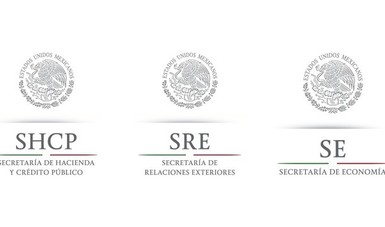Yesterday, the second video conference of follow up to the High-Level Economic Dialogue (DEAN, by its initials in Spanish) between Mexico and the United States, took place. In this occasion it was chaired by the Secretary of Finance, Dr. Luis Videgaray Caso, and the Secretary of US Commerce, Penny Pritzker.
The DEAN was created by the presidents of Mexico, Enrique Peña Nieto, and of USA, Barack Obama, in May 2013, with the aim of forging a closer and productive economic relationship.
From Mexico, participated in the video conference, the Secretary of Foreign Affairs, José Antonio Meade; the Secretary of Economy, Ildefonso Guajardo; the Secretary of Communications and Transport, Gerardo Ruiz Esparza; as well as officials of the Presidency of the Republic and the Secretariats of Energy (SENER), of Labour and Social Welfare (STPS), of Agriculture, Livestock, Rural Development, Fisheries and Food (SAGARPA) and of Tourism (SECTUR); besides ProMéxico and the National Institute of the Entrepreneur (INADEM, all by its initials in Spanish).
On the US side, it was attended by representatives of the Office of the Vice President and the Departments of State, Transportation, Energy, Interior, Homeland Security, Agriculture, and the National Security Council.
The Videoconference allowed to monitor the progress of the DEAN, from the high-level meeting that took place within the framework of the visit of President Enrique Peña Nieto to the United States on last January.
During the meeting, the six priority areas of DEAN were reviewed: Energy, modern borders, workforce development, regulatory cooperation, partnership for the regional and global leadership, and participation of relevant actors in the private sector and civil society. These areas are driving the overall objectives of the Dialogue: promoting competitiveness and connectivity; promoting the economic growth, the productivity, the entrepreneurship and innovation; and develop our regional and global leadership.
In the energy sector, the identification of challenges and opportunities regarding the energy infrastructure was highlighted as well as the development of collaborative programs in sustainable energy and a Bilateral Business Council on energy.
On the subject of modern borders, the opening of three border infrastructure projects for 2015 was announced: the Brownsville-Matamoros railway bridge; the Guadalupe-Tornillo port of entry on the Chihuahua-Texas border and the airport connection Tijuana-San Diego; as well as the launch of the single manifest for rail freight (south-north traffic) and the development of single manifests of similar load in the categories of air, sea and land transport.
In the coming months, the Service of Tax Administration (SAT, by its initials in Spanish) and the Agency of Customs and Border Protection (CBP) will open some pilot programs of loading pre-inspection in the Laredo International Airport and in the area of exports in the Mexican customs of Mesa de Otay-Baja California.
In terms of human capital formation, the implementation of the Bilateral Forum on Higher Education, Research and Innovation (FOBESII) was emphasized; 30,901 Mexican students and teachers have participated in the exchange programs with institutions of higher education and innovation centers in the United States. Also, there were been signed 50 cooperation agreements between universities and institutions of both countries. They will continue to create synergies in strategic sectors through the science academies of both countries, promoting a greater collaboration between their governments and their private sectors.
Moreover, the Secretariat of Labor and the Department of Labor (DOL) work on the implementation of a cooperation project to eliminate the discrimination by gender and sexual preferences. With the government of California, the STPS (In Spanish initials) assists in the implementation of a Letter of Intent to develop a pilot project to combat irregularities in the work performed by the temporary workers.
Regarding the regulatory cooperation, Mexico and the United States agreed to identify the areas of opportunity to serve on the second working plan of the Council of High Level for Regulatory Cooperation.
Moreover, SAGARPA, the National Service of Health, Agriculture and Livestock Safety and Quality (SENASICA, by its acronym in Spanish) and the Department of Agriculture (USDA, by its acronym in English) agreed to advance on the cooperation to develop electronic systems of compatible certification for plants and animals.
On issues of regional and global leadership, they talked about collaborative projects during the presidency of Mexico of the Alliance for the Open Government in 2015, among them Mexico's advances in transparency in the sector of extractive industries and works to achieve Mexico's accession to the Initiative of Transparency of the Extractive Industry (EITI, for its acronym in English), as well as their commitment of working together on infrastructure and training schemes in customs matters with Central America.
The group also stressed the importance of involving all stakeholders in the DEAN, such as the tourism sector through the Working Group of Travel and Tourism with initiatives of exchange of data and information, facilitation of travels and promotion of the border tourism, in order to maintain its current and strategic character. The authorities of both countries maintain a close contact with business associations and educational institutions, among others, in order to receive feedback to strengthen the work of the DEAN.
Furthermore, it was agreed to hold the next High-Level meeting of the DEAN during the first quarter of 2016, in Mexico.
